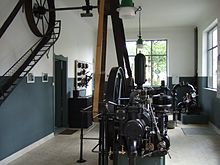Historic pumping station (Onstmettingen)
The historic pumping station , also known as the “Pumphäusle”, is an industrial monument in the Albstadt district of Onstmettingen . It stands near the town hall and is evidence of the development of a modern infrastructure in the formerly independent community of Onstmettingen.
history
Onstmettingen is centrally located in the headwaters of the Schmiecha . One source of the Schmiecha is the Kemmebach , which used to flow into a pond . This pond contained further springs, so that it had an annual mean of 15 ls −1 of water. The draining water flowed in a meandering course to the reed and there it flowed into the western Schmiecha. After long and heavy rainfall or when the snow melted , the reed and the area of the eastern Schmiecha were regularly flooded and were therefore marshland. During the settlement, the eastern part of the Schmiecha was relocated to dry out the area around the former stream bed . Around 1770 the source pot , i.e. the pond, was bordered with stones. The former tributary of the Kemmebach had already been diverted and no longer flowed into the pond. Since the risk of flooding persisted, the drain was straightened, deepened and widened in 1905. The spring pot has been used for water supply for centuries.
As part of the industrialization , a gas works was built in Onstmettingen , so the need for an own water supply network arose. In 1909 the area of the spring pot was bought by the municipality and a basin 9 × 9 meters and a depth of 2.5 meters was dug, lined with concrete and fitted with a slider . A ceiling was drawn in over the source pot, which was reinforced in the middle by two supports. The pump house with an attached workshop was built on this ceiling. A piston pump with a gas engine served as the water pump, which supplied the houses connected to the mains and the elevated reservoir on the Bergle with 10 ls −1 water. A handle pump was attached to the south side of the building . The elevated tank was behind the Löwe restaurant. This had a volume of 500 m 3 . After the village of Onstmettingen was supplied with electricity in 1923, the pump with gas engine was replaced by an electric pump. In 1930 a second pump was installed to provide redundancy for repairs.
In the early 1950s, a sewage network was built in Onstmettingen and the water table was lowered through drainage , which led to regular water shortages. Also the water quality was poor by built around the pump Häusle around crap and slurry pits and the number of coliform bacteria increased. Due to the settlement of refugees, the population doubled. The textile industry also needed more and more water. So that the municipality of Onstmettingen could continue to be supplied with sufficient water, the municipality joined the water supply association Zollernalb . This ended the independent water supply in 1953.
The Pumphäusle was preserved as an industrial monument and can be visited on rare occasions.
literature
- So it was in Onstmettingen issue 14: Our water , published by the Onstmettingen Working Group, 1996
Coordinates: 48 ° 17 ′ 7.8 " N , 9 ° 0 ′ 6.8" E



